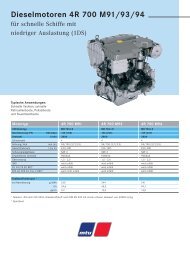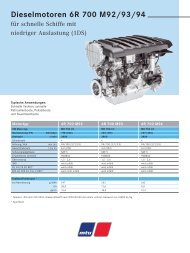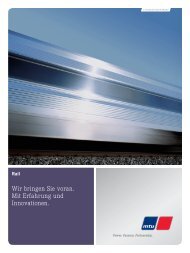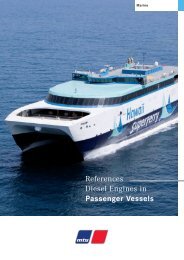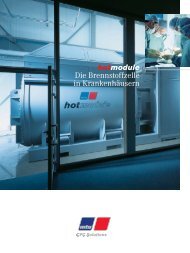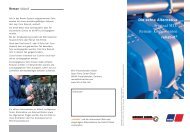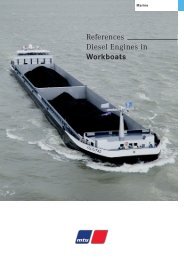You also want an ePaper? Increase the reach of your titles
YUMPU automatically turns print PDFs into web optimized ePapers that Google loves.
Training <strong>of</strong>f the Scottish coast: the PACSCAT beaches and remains stable whilst the amphibious vehicles leave the landing craft.<br />
QinetiQ selected extremely experienced partners for the project: Griffon<br />
Hoverwork for construction, BMT Nigel Gee for design and BMT Marine<br />
Projects for project management support and together they planned, developed<br />
and built the new hovercraft-catamaran. The extensive cargo bay<br />
can accommodate five amphibious vehicles, a tank or troops. The craft is<br />
propelled by twin waterjets powered by two 16-cylinder, Series 4000 highspeed<br />
diesels from <strong>MTU</strong>. Two further engines inflate the hover cushions<br />
which allow the vessel to achieve even higher speeds whilst the catamaran<br />
hull design lends the PACSCAT the stability it needs on shore. At least, that<br />
is how it works in theory.<br />
Faster than expected<br />
After three years <strong>of</strong> planning and construction, the project moved into its<br />
practical phase in fall 2010, initially at its home port <strong>of</strong> Instow (England) and<br />
then in Scotland. After only a few hours afloat, R&D personnel began to realize<br />
just what the hovermaran landing craft was capable <strong>of</strong>. It mastered the<br />
first 100 hours and the speed trials with no problems, and it was fast – so<br />
fast that it reached almost 40 knots (74 kph) unladen. The powerful <strong>MTU</strong><br />
engines actually propel the PACSCAT whilst the inflated air cushion allows<br />
it to achieve its top speeds by lifting the hull in the water and reducing drag.<br />
“<strong>MTU</strong> engines deliver the best power-to-weight ratio. That is vital in a pro-<br />
28 I <strong>MTU</strong> Report 02/11<br />
ject like this where every kilo counts,” explained Chris Ross, Chief Naval<br />
Architect at QinetiQ. In addition to the 2,720 kW <strong>of</strong> power which the <strong>MTU</strong><br />
engines generate, they have the extra benefits <strong>of</strong> robustness and reliability,<br />
essential features when the task involves getting soldiers and vehicles out<br />
<strong>of</strong> the danger zone as fast as possible.<br />
Training with the Royal Marines<br />
Following the speed trials in England, tests continue <strong>of</strong>f the Scottish coast<br />
– this time on duty with the Royal Marines. The PACSCAT is given the task<br />
<strong>of</strong> taking cargos <strong>of</strong> different weights on board and transporting them. The<br />
trials start on the beach where its twin hulls give the craft stability in the<br />
shallow water. One after the other, five amphibious vehicles roll slowly <strong>of</strong>f<br />
the beach into the water and toward the landing craft. Half-submerged and<br />
with their headlights still just visible, the vehicles float through the water<br />
like crocodiles until they slowly begin to creep up the PACSCAT ramp onto<br />
the craft. With all five on board, the flap closes and the vessel casts <strong>of</strong>f.<br />
The waves swell, forming a barrier against the catamaran, but present no<br />
appreciable problem for the vessel, especially not after the air cushions are<br />
inflated.That means the second task has been mastered: the PACSCAT is<br />
not only fast, it can also transport heavy payloads.



